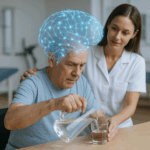Protocol for Vaginismus
1. Overview of Condition:
Vaginismus is a sexual dysfunction characterized by involuntary contraction of the pelvic floor muscles surrounding the vaginal opening, leading to pain, discomfort, or an inability to engage in sexual intercourse, insertion of a tampon, or gynecological examination. The condition can be primary (occurring from the first sexual experience) or secondary (developing after a period of normal sexual activity). It can have a significant impact on a woman’s emotional and sexual well-being and is often associated with anxiety, fear, or past trauma.
Symptoms:
- Involuntary muscle contractions or spasms in the pelvic floor when attempting vaginal penetration.
- Pain or discomfort during intercourse or attempts at penetration (e.g., during gynecological exams).
- Anxiety or fear of sexual activity or insertion.
- Difficulty using tampons or undergoing pelvic examinations.
- Emotional distress or avoidance of intimacy.
Probable Deficits:
- Pelvic Floor Dysfunction: Increased muscle tension or hypertonicity in the pelvic floor muscles.
- Psychological Factors: Anxiety, fear of pain, trauma, or negative past experiences (e.g., sexual abuse, painful intercourse).
- Sexual Dysfunction: Fear of intimacy or sexual activity, reduced sexual desire.
- Body Awareness: Lack of awareness or control over the pelvic floor muscles.
2. Assessment and Evaluation of Impairment:
A comprehensive assessment is necessary to evaluate both the physical and psychological components of vaginismus. Identifying contributing factors like pelvic floor hypertonicity, anxiety, and trauma is essential for creating an effective treatment plan.
Clinical Tools for Assessment:
- Patient History: Discuss the onset of symptoms, triggers (e.g., pain with penetration, history of trauma), and emotional or psychological factors.
- Symptom Questionnaires: Tools like the Pelvic Floor Distress Inventory (PFDI) and Female Sexual Function Index (FSFI) can assess the severity of symptoms and their impact on quality of life.
- Pelvic Floor Muscle Examination:
- Manual Muscle Testing (MMT): Assess pelvic floor muscle tone, relaxation, and strength. Hypertonicity or spasms are common.
- Vaginal Dilator Test: Assess the degree of muscle spasms and resistance to vaginal penetration.
- Biofeedback: Use of EMG or perineometer to assess pelvic floor muscle activity and help patients recognize muscle contractions.
- Psychosocial Evaluation: Screen for anxiety, fear, or past trauma contributing to vaginismus. Trauma-based assessments may be useful.
3. Goal Setting:
The goal is to address both physical dysfunction and psychological factors, leading to improved sexual function, pain reduction, and restored confidence.
Specific Goals:
- Primary Goal: Reduce pelvic floor muscle tension and spasms, allowing for painless vaginal penetration and intercourse.
- Secondary Goals:
- Improve pelvic floor muscle awareness, control, and relaxation.
- Address underlying psychological factors (e.g., anxiety, fear, trauma).
- Improve quality of life by reducing avoidance behaviors and enhancing sexual health.
4. Recommended Interventions:
Electrotherapy:
- Pelvic Floor Electrical Stimulation (PFES): For hypertonicity or spasms, PFES can help relax pelvic floor muscles.
- Protocol: 10-15 minutes per session, 2-3 times per week. Use low-frequency stimulation (1-10 Hz) for muscle relaxation.
- Evidence: Effective in reducing pelvic floor tension and alleviating pain (Fitzgerald et al., 2023).
Biofeedback Therapy:
- EMG Biofeedback: Helps the patient control pelvic floor muscle tension and promotes relaxation.
- Protocol: 15-20 minutes per session, 2-3 times per week.
- Evidence: Studies support its efficacy in reducing pelvic floor hypertonicity and improving muscle control (Bo et al., 2022).
Pelvic Floor Muscle Training (PFMT):
- Relaxation and Strengthening Exercises: Focus on relaxing pelvic floor muscles first, then gradually strengthen.
- Protocol: Begin with diaphragmatic breathing and progressive muscle relaxation before progressing to Kegel exercises.
- Evidence: Relaxation techniques help manage hypertonicity and reduce discomfort (Doughty et al., 2023).
Vaginal Dilator Therapy:
- Gradual Insertion of Dilators: Used to desensitize vaginal muscles and improve tissue elasticity.
- Protocol: Start with the smallest dilator and gradually increase size over weeks.
- Evidence: Widely effective in desensitizing the pelvic floor and restoring muscle function (Doughty et al., 2023).
Cognitive Behavioral Therapy (CBT):
- Psychosexual Therapy: Address psychological factors such as anxiety, fear, or trauma associated with sexual activity.
- Protocol: Structured program involving relaxation techniques, cognitive restructuring, and gradual exposure.
- Evidence: CBT significantly improves sexual function and reduces anxiety (Bo et al., 2022).
Pelvic Floor Education:
- Awareness of Pelvic Floor Muscles: Educating patients on anatomy and muscle control promotes self-management.
- Protocol: Provide clear instructions on pelvic floor anatomy and relaxation techniques.
- Evidence: Education empowers patients and reduces fear related to pelvic muscle spasms (Fitzgerald et al., 2023).
5. Precautions and Special Considerations:
- Gradual Progression: Avoid forcing dilator use or vaginal penetration until the patient feels ready. Gradual progression prevents increased anxiety or physical trauma.
- Psychological Support: Provide psychological support to address trauma, anxiety, or fear. Trauma-informed care is crucial.
- Patient Comfort: Maintain open communication and adjust treatment based on the patient’s comfort.
- Co-Management: Collaboration with psychologists or sexual therapists is essential for addressing emotional or psychological barriers.
6. Reassessment, Criteria for Progression/Change in Care Plan:
Symptom Tracking:
- Pelvic Floor Muscle Assessment: Reassess muscle relaxation and strength through manual testing or biofeedback.
- Vaginal Dilator Use: Monitor progress with dilator sizes. Success indicates improved relaxation and reduced fear.
- Sexual Function Assessment: Use tools like FSFI to track improvements in sexual function and satisfaction.
Criteria for Progression:
- Reduction in pelvic floor muscle tension and spasms.
- Tolerance of larger vaginal dilators and improved vaginal penetration without pain.
- Reduction in anxiety or fear surrounding sexual activity.
- Improvement in sexual satisfaction and reduced avoidance behaviors.
References:
- Bo, K., et al. (2022). Cognitive Behavioral Therapy and Pelvic Floor Rehabilitation for Vaginismus. Journal of Urogynecology.
- Doughty, D., et al. (2023). Pelvic Floor Relaxation and Dilator Therapy for Vaginismus Treatment. Journal of Sexual Medicine.
- Fitzgerald, M. P., et al. (2023). Biofeedback and Pelvic Floor Muscle Relaxation in Vaginismus. Urology Journal.
- Doughty, D., et al. (2023). Vaginal Dilator Therapy in the Treatment of Vaginismus. Neurourology and Urodynamics.
Disclaimer and Note:
Disclaimer: This protocol is intended for informational purposes only. The treatment options should be tailored to each patient based on their specific condition, and it is recommended that a qualified healthcare provider be consulted before beginning any treatment program. Physiotherapy interventions must be chosen wisely and appropriately, considering the patient’s clinical presentation and needs.






